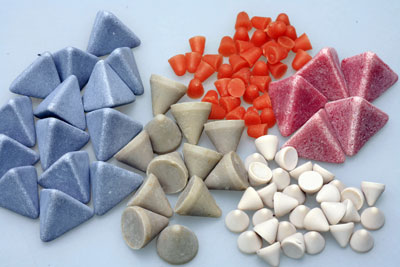Choice of tumbling material for vibratory deburring machines
A deburring machine commonly used for mass finishing parts
is a vibration deburrer, which uses an abrasive agent to deburr, clean or
polish unfinished or dirty parts or objects. Abrasive media and unfinished or
dirty parts are placed in a large drum. The drum vibrates, sending the contents
down in a circular motion while mixing. Unfinished or dirty parts are then
deburred, cleaned or polished by rubbing with the abrasive material.


The type of deburring, cleaning or polishing desired and the
characteristics of the part will determine the type, shape and size of the
abrasive medium used. Abrasive steel, plastics, ceramics and organic materials
are common types of tumbling materials. These materials can be purchased in a
variety of shapes, such as stars, pyramids, cones, wedges, spheres, cylinders,
ovals and other shapes depending on the function required. Holes or slots in
the pieces will determine the size and shape of the media used. To prevent the
support from getting into the room, the size of the hole or slot must be at
least 70%. This prevents two pieces from getting stuck side by side in the
room.
Here are some common uses of abrasive media:
Steel Brackets - Use for deburring, polishing, polishing and
burnishing of metal, plastic or ceramic parts. Since plastics have a high
abrasion resistance resulting in a matte finish after deburring, a second
polishing step is often required.
Ceramic or Graduated Stone Media - Use for light and heavy
deburring and when rapid deburring is required. Suitable for hard and heavy
metals (such as steel or stainless steel) and for rust removal on parts. Use
for general purpose polishing. Plastic, steel, stainless steel and aluminum
parts are often polished with a ceramic support. Use beads to polish aluminum
to avoid nicks.
Plastic Brackets - Use for metal deburring, precision
deburring, polishing and polishing. Use on softer metals such as aluminum or
brass and on threaded parts.
Organic media (nutshells, coconuts, corncobs) - Use nut
shells and coconut shells for medium to light deburring. For light finishing
and polishing, use walnut, coconut and corn cake. To clean and dry wet or dirty
parts, use organic media. The corn cob is particularly desirable for finishing
some metal parts because of its ability to absorb surface oils on parts. The
use of organic carriers is advantageous because they are natural,
environmentally safe, biodegradable, durable and reusable.
Wet Mixtures - Used in combination with solid supports for
deburring, finishing and polishing parts, their function is to clean, improve
deburring and protect against corrosion and rust.
The abrasive medium for deburring equipment wears slowly,
but its aggressiveness varies. In addition, the smaller the support, the better
the finish, but the longer the time will be. The bigger the support, the faster
it will be deburred. Having the correct support and the deburring machine full
of parts is the key to the success of the finish.
Helpful Links:
Comments
Post a Comment